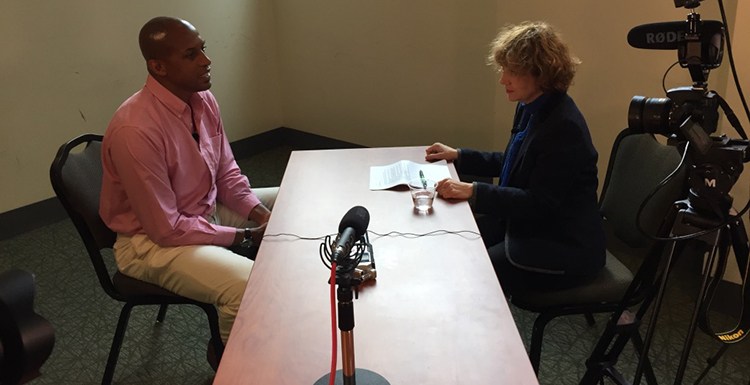 In a time of increasing anxiety about Islam in much of American society, how are universities responding to expressions of faith by their Muslim students? In new research focusing on George Mason University, Anne Daguerre explored issues of faith and national policy within university life. Here, she discusses her findings and reflects on their wider cultural context.
In a time of increasing anxiety about Islam in much of American society, how are universities responding to expressions of faith by their Muslim students? In new research focusing on George Mason University, Anne Daguerre explored issues of faith and national policy within university life. Here, she discusses her findings and reflects on their wider cultural context.
Ethnic diversity has become a permanent feature of contemporary Western societies, with religion – for example, Islam – being increasingly perceived as a form of social identity for non-majority ethnic groups. In Western Europe, there appears to have been a renewed cultural and political anxiety regarding the perceived threat of Islam to a distinctively European secular consensus.
The expression of a strong Muslim identity could potentially undermine this secular consensus in higher education, where matters of faith are usually confined to the private sphere. Of course, the revival of religion is not confined to Islam, but the Muslim faith is arguably the most visible on modern campuses today.
In light of this, it’s important to understand how national debates and policies regarding the place of Muslims in American society interact with the representation of Islam in American university life. My recent research addresses the question: how do universities respond to the expression of the Muslim faith in their midst at a time of growing social and political anxiety regarding Islam, especially in Western Europe?
With this in mind, I investigated Obama’s policies regarding religious diversity, Trump’s anti-immigrant and anti-Muslim stance, and the reaction to Trump’s ‘Muslim ban’ at George Mason University. A fourth dimension of the research focused on how students and staff experienced religious and cultural diversity on campus and what type of policies had been put in place by university management structures.
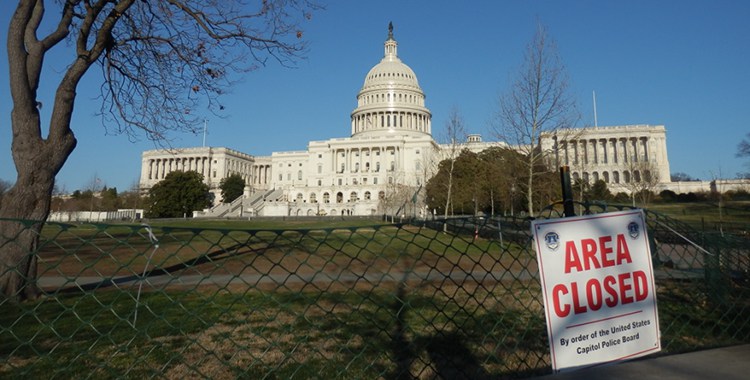
Capitol Hill: photo by Nick Lazar, used with permission
The representation of Muslims in the United States
In the United States, fear of Islam and Muslims is less predominant than in Western Europe for three important reasons. First, the influence of religion is exceptionally strong in America. Religion is traditionally seen as a vector of social integration in the American melting pot. Second, Muslims remain a tiny minority in the US: there are 3.35 million Muslims of all ages in the U.S., which represents about 1 percent of the U.S. population. By contrast, the percentage of Muslims in European countries is much higher than in the US: in 2010, Muslims represented 7.5 percent of the population in France, 4.8 percent in the UK, 5.8 percent in Germany, 3.7 percent in Italy, 4.1 percent in Denmark, 5.4 percent in Austria and 4.6 percent in Sweden. Third, American Muslims tend to be better integrated than their European counterparts mainly because religion is seen in a more positive light in America than in Western Europe.
Indeed, there’s usually a great deal of organizational and political space for the expression of the Muslim faith. This also applies to universities, where Muslims are between 1 and 1.4 percent of the student population. The Muslim Student Association (MSA) has been a prominent advocate for the official recognition of Muslim students’ specific needs, especially in terms of worship and dietary requirements. Universities have been generally responsive to these demands.
However, it would be misguided to conclude that it’s been all plain sailing for American Muslims. Just like in Western Europe, the fear of Islam is alive and well in the US, especially after 9/11. Hate crimes against Muslims rose sharply in the immediate aftermath of the attacks, including on American campuses. More recently, there’s been a spike in both Antisemitism and Islamophobia on American campuses, as well as hate crimes against African American students, prompting colleges to enhance diversity training and multicultural education for their communities.
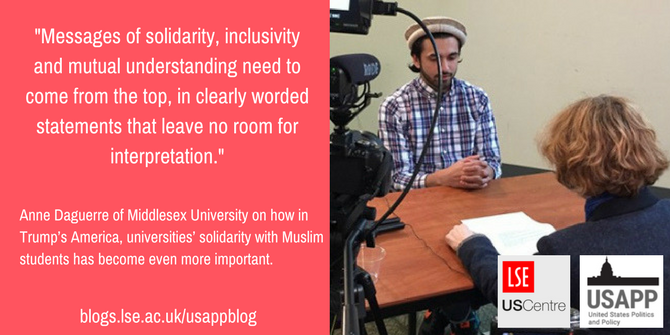
Two presidents, two narratives
Americans are torn between two radically conflicting representations of their own history. The first, highly idealised narrative is that of an open and generous country that welcomes immigrants regardless of their ethnicity or religion. The cultural diversity of the nation is something to be treasured and cherished, with an absolute protection of the freedom of religion. In this vision, Muslims are part and parcel of a multi-faith, multicultural America. This is the post-racial, optimist vision embodied by the presidency of Barack Obama, with the slogan: ‘Hope we can believe in.’
Towards the end of Obama’s second term, the White House made deliberate efforts to build bridges with the American Muslim community, which included celebrating the positive contribution of Muslims to American society. In February 2016, President Obama visited a mosque in Baltimore and condemned the rise of Islamophobia in American society. The White House appointed Zaki Barzinji as a liaison to the Muslim American community under the Office of Public Engagement.
The second narrative, now represented by President Donald Trump, is equally strong: it’s a vision of a predominantly white, Christian America that needs to close its borders and focus on looking after its natives. This is an older, white America that fears being replaced by younger minority ethnic groups in the not-so-distant future. It’s a nation gripped by the fear of becoming culturally and economically irrelevant. These competing narratives dictate the differences in terms of attitudes towards Muslims between the Obama and the Trump White House.
In contrast to the interfaith outreach efforts which characterised the Obama administration, Donald Trump’s most influential advisers – Steven Bannon, who left the White House in August 2017, and Stephen Miller –have seemed to be obsessed with the notion of a Muslim-liberal alliance that is bent on destroying a white American culture. Miller has been the main architect of the Muslim travel ban, the executive order issued by Donald Trump on 27 January 2017 which temporarily prohibited entry to refugees and immigrants from seven Muslim countries. The executive order drew strong criticism from American universities.
The reaction to the travel ban at GMU
At GMU, the reaction was immediate. The President of the University, Angel Cabrera, posted a letter on the 29th of January stating his deep concern, ‘urging the administration to reconsider this executive action and reverse course.’ One student, Najwa Elyazgi, was prevented from coming back from Libya after the travel ban. Her ordeal lasted a week, after which she was allowed to re-enter the United States.
Since then, the controversy has died down. It looks as if the revised travel ban would have no impact on foreign students or staff coming from the countries under scrutiny, since an invitation to work or study at a university would qualify as a ‘bona fide’ relationship with the US.
If anything, in January-February 2017, Muslim students were pleasantly surprised by the strong, spontaneous reaction of solidarity emanating from various quarters of American civil society. They also felt supported by senior management and academic staff. As a professor told me, ‘there’s power in numbers’.
Anne Daguerre with Mika’il Petin, Associate Director of African and African American Studies at GMU. Photo: Nick Lazar.
A visible Muslim student community
Throughout my six-month stay, I interviewed several Muslim students from various backgrounds. The majority felt their faith was a very important component of their life and their identity, and were keen to challenge anti-Muslim stereotypes.
Interviewees were generally happy with the level of support offered by GMU with respect to the accommodation of their religious needs. Indeed, the university has made tremendous efforts to provide an environment where Muslims can practise their faith, with quiet meditation spaces and foot-washing facilities in nearby bathrooms.

Umar Farooq, president of the MSA at GMU. Photo: Nick Lazar
Tensions around the meditation space and micro-aggressions
Although it’s open to everyone, the mediation space tends to be mostly used by Muslim students. There are regular complaints that the University sponsors the Islamic faith, thus violating the first Amendment of the US Constitution which prohibits Congress from preferring or elevating one religion over another. But these complaints have for the most part fallen on deaf ears, because the space is explicitly dedicated to meditation, not prayer.
Anecdotally, two respondents reported incidents of micro-aggressions by professors or on social media, but such incidents are difficult to prove. The Office of Ethics and Compliance said that although Muslim students have complained about Islamophobia on campus, it was more a subjective feeling than anything concrete. This did not mean that the university was not taking these complaints seriously. The Office of Diversity, Inclusion and Multicultural Education (ODIME) launched courses to help staff to become more aware of cultural and religious diversity, and the Campus Climate Group also closely monitors the atmosphere on campus.
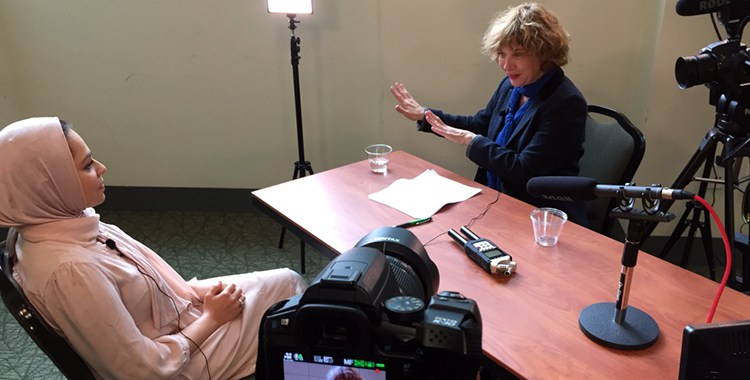
Myra Khan, Student Care and Conduct Coordinator, GMU. Photo: Nick Lazar
The role of the Muslim Student Association (MSA)
On the whole, campus relations appeared to be quite harmonious at GMU, with no obvious tensions between various parts of the student body. I’d argue that part of the reason for this state of affairs could be that there’s been no overlap between pro-Palestinian, anti-Israel activism and the MSA. The MSA at GMU functions as a congregation that helps Muslim students develop a sense of belonging and solidarity. The leadership presents a positive image of Islam as a tolerant and open faith in phase with American constitutional values.
Muslims students identify with America, despite often being targeted by Islamophobia
I drew three main conclusions from the research. First, listening to Muslim students and staff at GMU helped deflate the image of Muslims as being fundamentally different from the rest of the student population. In particular, there was absolutely no evidence of an oppositional political identity; on the contrary, all interviewees identified with American civic values. That’s why it’s so crucial to keep challenging anti-Muslim stereotypes. The voice of young Muslims is a powerful one. It’s also important to listen to other faith or secular groups, as any perception of a hierarchy of demands within the university quickly gives rise to a feeling of injustice and resentment.
Second, while there was no perceived rise in Islamophobia on campus, Muslim female students were more likely to feel targeted, mainly from wearing the hijab. The political climate and Donald Trump’s rhetoric explained this higher sensitivity. Moreover, there were a series of high profile religiously-motivated crimes during the month of Ramadan. In June 2017, in Sterling, northern Virginia, a 17 year old girl, Nabra Hassanen, was abducted and beaten to death on the way back from the mosque. The police said the killing was the result of ‘road rage’; this version of events has been highly criticised by the local Muslim community.
Although the exact motives of the crime may never become completely clear, there’s no denying that Muslim women have become increasingly vulnerable to ‘gendered Islamophobia’. I would argue it’s urgent to take a principled stance that acknowledges these feelings and expresses solidarity with potential targets. It’s precisely because there was such a big pushback against the travel ban that Muslim students continued to feel positively welcome at GMU. Strongly worded messages from the university’s president did make a difference to Muslim students. Messages of solidarity, inclusivity and mutual understanding need to come from the top, in clearly worded statements that leave no room for interpretation.
Third, mutual dialogue between both people of faith and no faith is key to the building of trust and a sense of belonging. This does not mean that difficult issues should be brushed under the carpet. Robust disagreement is healthy; students should be given the tools to accept that it’s fine ‘to agree to disagree’. This is the challenge and the promise of the multicultural campus.
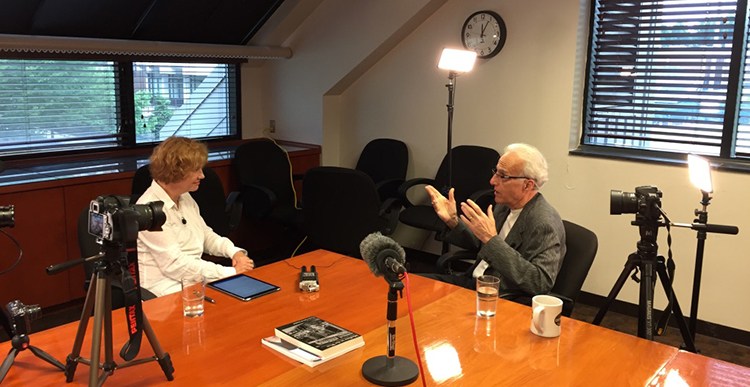
John Esposito, American professor of International Affairs and Islamic Studies at Georgetown University. Photo: Nick Lazar.
- A version of this article originally appeared at Middlesex Minds.
Please read our comments policy before commenting.
Note: This article gives the views of the author, and not the position of USAPP– American Politics and Policy, nor of the London School of Economics.
Shortened URL for this post: http://bit.ly/2AFgbha
_________________________________
About the author
 Anne Daguerre – Middlesex University
Anne Daguerre – Middlesex University
Anne Daguerre is an Associate Professor in Work Employment and Welfare at Middlesex University, London and an alumna of the Woodrow Wilson Center. A specialist in welfare reform, her current research makes comparative study of the US and the UK


